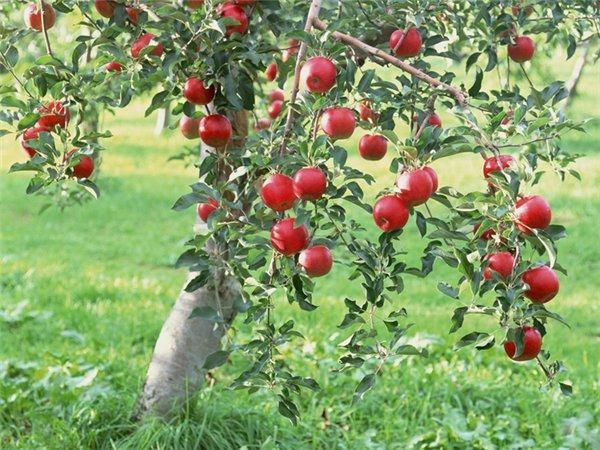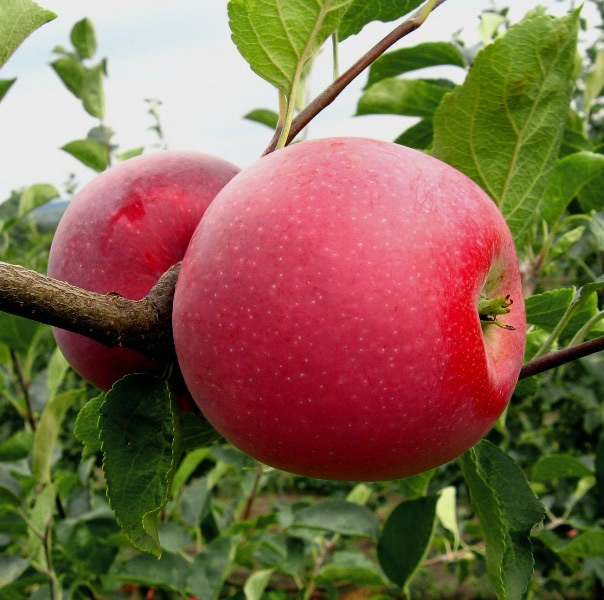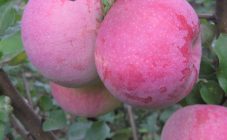Content:
Apples are considered the most widely grown fruit crop in the world. Varietal varieties differ from each other in taste, fruiting season, pulp structure and fruit color. Sweet varieties are considered the most preferred among summer residents. Apples of northern apple varieties contain a lot of acids in their composition. The most sugar varieties grow in the southern regions, since the south of the country is characterized by a large number of hot sunny days. However, despite this, there are sweet hybrids that are resistant to cold growing conditions. The honey apple tree belongs to this segment.
History of creation
The apple tree is a fruit tree grown in both the northern and southern regions. The first cultivated trees began to grow more than five thousand years ago. The most common varietal variety of this plant is the Domashnyaya apple tree.
1935 - the date of breeding the Medovoye variety. The author of the project is S.A. Isaev, a biologist specializing in plant breeding. The material used to obtain the hybrid was two varieties: Wellsey with Brown Striped. The main task of the breeding was to develop a variety capable of growing in conditions of -38 ° C air temperature, as well as abundantly bearing fruit. The planting of the first seeds was carried out in 1936, the harvest - in 1944. Despite the fact that this variety is suitable for growing in any climatic zone of our country, the southern climate is considered the most favorable.
Description of the variety
A series of varieties apple Honey belongs to the category of dessert. The fruits are distinguished by their sweet taste and rich aroma. The structure of the flesh is fine-grained, cream color. This is a summer variety. Fruits are characterized by the presence of dietary properties - the calorie content of these apples is negligible. The shape of the fruit is round, size is medium, weight is 100 grams, color description of the fruit of the Medovka apple tree is (base) yellow with green and pink-red, the peel has a dense structure.
The height of the tree is about 5 meters. The type of branches is spreading, the color is brown. The shape of the crown is pyramidal. The root system is highly branched, does not undergo deformation from groundwater located nearby. The color of the leaves is deep green, the shape is narrowed, with a bend in the center, the structure of the leaf is rough, the young foliage has pubescence on the veins. The flowers are white, each 5 centimeters in diameter.
The varietal apple tree Medovka has two most famous subspecies:
- Honey Crunch (Honey Crisp) is an industrial subspecies of the honey apple variety most common in Canada and the United States. Harvesting takes place in mid-October. Each crispy apple is large in size, elongated-conical in shape. The pulp has a juicy consistency and sweet taste. The color of the fruits (base) is yellow-green and scarlet-red, the color of the flesh is creamy. The rind has a dense structure and a smooth surface. Cool room conditions allow the shelf life to be extended up to 7 months. A tree of small height. The shape of the crown is narrow oval.The plant is distinguished by winter hardiness, as well as resistance to many diseases, including scab and powdery mildew. List of apple pollinating varieties Honey crunch:
- Idared;
- Golden Delicious;
- Askold;
- Ruddy climber.
The beginning of fruiting is carried out four years after planting in a permanent place. The crop is suitable for long distance transportation, whether it is standard transport in boxes or as a parcel of fruit to another country, for which the mail is used.
- Honey ranet is an autumn apple variety. The beginning of harvesting falls on the first days of the calendar autumn, the end - in the middle of October. The shape of the apple tree Honey Ranet is characterized as slightly elongated, pale yellow in color, the rind has a waxy coating. The pulp has a juicy consistency, white color, sweet taste. The tree is distinguished by good winter hardiness, but it is prone to the appearance of foci of the moth.
The variety is resistant to most diseases, but it is necessary to take preventive measures, including against the appearance of rodents.
Agricultural technology of cultivation
The recommended soil for planting seedlings of the Honey Apple tree is loamy drained. The soil must be watered after planting with two buckets of water. The site should be well lit by the sun.
You can plant an apple tree both in early spring and in autumn. Planting of planting material should be carried out in compliance with the 5-meter distance between seedlings. The planting indentations should be created exactly two weeks before the apple tree is placed in its permanent location. The depth of the pit is one meter, it must also be wide - the creation of this condition is necessary for the possibility of unhindered development of the root system in the horizontal direction. In addition, a mixture of humus and compost must be added. The base of the root fork should be 5 centimeters above the ground.
Sub-winter planting should be carried out a month before the first frost, so that the tree has time to take root and not die during the winter season. However, if warming occurs, the process of sap flow will begin.
During the first two years from the moment of planting, it is necessary to install support stakes on both sides of the tree, with the presence of fortifications.
Autumn planting is recommended for the following regions:
- Caucasian District;
- Volga region;
- Central Federal District (including Moscow and the region).
Regions not recommended for growing this variety:
- Siberia;
- Ural region;
- Far Eastern region.
How to care for a tree
Watering should be carried out in hot weather. An adult tree requires 38 liters of water for irrigation, an annual one - ten liters, applied every 4 days. In relatively hot weather, pour the required amount of water into the near-stem area once every two weeks.
In the spring, sodium humate is introduced into the soil. In autumn, phosphorus and potassium are used for fertilization. Nitrogen and urea in the mineral mixture help to accelerate plant growth.
At the beginning of the spring season, before the tree goes into the budding stage, planting care consists in the need for sanitary pruning. This care measure is to remove dried branches and small root growth. In this case, an inverted pyramidal shape must be observed. Treat fresh cuts with garden varnish or water-based paint.
How to properly store the crop
If you wait until the fruits are fully ripe on the tree, the quantitative indicator of the yield can be about 80 kilograms. The tree's ability to bear fruit lasts for a decade. In the future, this process becomes cyclical.
The earliest harvesting date is mid-August, but by this time the fruits ripen not completely and evenly.
The correct collection of apples consists in removing them, first of all, from the branches of the lower tier, leaving the stalk and avoiding deformation of the peel. Dry weather is considered the best time.
To create storage conditions for 7 months after harvesting, you must:
- Sort apples into deformed and whole;
- Create storage areas for distributed fruits;
- Prepare wooden boxes for storage;
- Wrap each fruit in paper - this will prevent the fruit from contacting each other and the occurrence of deformations;
- Place the crop in a storage room with a constant + 5 ° C air temperature.
Positive and negative qualities of the variety
The list of descriptions of the advantages of the Honey apple tree, in comparison with other varieties, includes:
- Winter hardiness;
- Resistance to diseases of scab and fruit rot;
- Stable crop abundance;
- Apples do not shatter;
- Sugar consistency of the fruit;
- Excellent taste;
- Bright apple aroma;
- Suitability for long-term storage;
- Unpretentious care;
- No need for special treatments.
The disadvantages of the variety are:
- The need to maintain the shape of the crown;
- The roots do not respond well to stagnant water;
- Exposure of the cortex to damage by rodents.
The honey apple tree is a summer variety that is very popular among domestic gardeners for its dessert fruits and the tree's unpretentious care. In addition, this variety is suitable for cultivation in many regions of the country.















